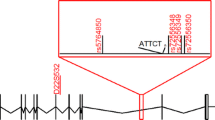Abstract
Spinocerebellar ataxia type 7 (SCA7) is a neurodegenerative disorder characterized by progressive cerebellar ataxia associated with macular degeneration that leads, in the majority of patients, to loss of autonomy and blindness. The cause of the disease has been identified as (CAG) n repeat expansion in the coding sequence of the ATXN7 gene on chromosome 3p21.1. SCA7 is one of the least common genetically verified autosomal dominant cerebellar ataxias found worldwide; however, we previously identified the Mexican population showing high prevalence of SCA7, suggesting the occurrence of a common founder effect. In this study, haplotype analysis using four SCA7 gene-linked markers revealed that all 72 SCA7 carriers studied share a common haplotype, A-254-82-98, for the intragenic marker 3145G/A and centromeric markers D3S1287, D3S1228, and D3S3635, respectively. This multiloci combination is uncommon in healthy relatives and Mexican general population, suggesting that a single ancestral mutation is responsible for all SCA7 cases in this population. Furthermore, genotyping using 17 short tandem repeat markers from the non-recombining region of the Y chromosome and further phylogenetic relationship analysis revealed that Mexican patients possess the Western European ancestry, which might trace the SCA7 ancestral mutation to that world region.

Similar content being viewed by others
References
David G, Durr A, Stevanin G, Cancel G, Abbas N, Benomar A, et al. Molecular and clinical correlations in autosomal dominant cerebellar ataxia with progressive macular dystrophy. Hum Mol Genet. 1998;7:165–70.
Horton LC, Frosch MP, Vangel MG, Weigel-Difranco C, Berson EL, Schmahmann JD. Spinocerebellar ataxia type 7: clinical course, phenotype-genotype correlations, and neuropathology. Cerebellum. 2013;12:176–93.
David G, Abbas N, Stevanin G, Dürr A, Yvert G, Cancel G, et al. Cloning of the SCA7 gene reveals a highly unstable CAG repeat expansion. Nat Genet. 1997;17:65–70.
Moseley ML, Benzow KA, Shut LJ, Bird TD, Gómez CM, Barkhaus PE, et al. Incidence of dominant spinocerebellar and Friedreich triplet repeats among 361 families. Neurology. 1998;51:1666–71.
Magaña J, Tapia-Guerrero Y, Velázquez-Pérez L, Cerecedo-Zapata C, Maldonado-Rodríguez M, Jano-Ito J, et al. Analysis of CAG repeats in five SCA loci in Mexican population: epidemiological evidence of a SCA7 founder effect. Clin Genet. 2013. doi:10.1111/cge.12114.
David G, Giunti P, Abbas N, Coullin P, Stevanin G, Horta W, et al. The gene for autosomal dominant cerebellar ataxia type II is located in a 5-cM region in 3p12–p13: genetic and physical mapping of the SCA7 locus. Am J Hum Genet. 1996;59:1328–36.
Stevanin G, David G, Dürr A, Giunti P, Benomar A, Abada-Bendib M, et al. Multiple origins of the spinocerebellar ataxia 7 (SCA7) mutation revealed by linkage disequilibrium studies with closely flanking markers, including an intragenic polymorphism (G3145TG/A3145TG). Eur J Hum Genet. 1999;7:889–96.
Young KL, Sun G, Deka R, Crawford MH. Paternal genetic history of the Basque population of Spain. Hum Biol. 2011;83:455–75.
Myres NM, Rootsi S, Lin AA, Järve M, King RJ, Kutuev I, et al. A major Y-chromosome haplogroup R1b Holocene era founder effect in Central and Western Europe. Eur J Hum Genet. 2011;19:95–101.
Martín P, García-Hirschfeld J, García O, Gusmão L, García P, Albarrán C, et al. A Spanish population study of 17 Y-chromosome STR loci. Forensic Sci Int. 2004;139:231–5.
Ambrosio B, Dugoujon JM, Hernández C, De La Fuente D, González-Martín A, Fortes-Lima CA, et al. The Andalusian population from Huelva reveals a high diversification of Y-DNA paternal lineages from haplogroup E: identifying human male movements within the Mediterranean space. Ann Hum Biol. 2010;37:86–107.
Valverde L, Köhnemann S, Rosique M, Cardoso S, Zarrabeitia M, Pfeiffer H, et al. 17 Y-STR haplotype data for a population sample of residents in the Basque country. Forensic Sci Int Genet. 2012;6:e109–11.
Valverde L, Rosique M, Köhnemann S, Cardoso S, García A, Odriozola A, et al. Y-STR variation in the Basque diaspora in the Western USA: evolutionary and forensic perspectives. Int J Legal Med. 2012;126:293–8.
Regueiro M, Álvarez J, Rowold D, Herrera RJ. On the origins, rapid expansion and genetic diversity of Native Americans from hunting-gatherers to agriculturalists. Am J Phys Anthropol. 2013;150:333–48.
Demard JC. Émigration française au Mexique: 1, Les communautés agricoles (1828–1900). 1st edn. Dominique Guéniot, éditeur. Langres; 1995. p. 91.
Stevanin G, Giunti P, Belal GD, Dürr A, Ruberg M, Wood N, et al. De novo expansion of intermediate alleles in spinocerebellar ataxia 7. Hum Mol Genet. 1998;7:1809–13.
Manrique RK, Noval S, Aguilar-Amat MJ, Arpa J, Rosa I, Contreras I. Ophthalmic features of spinocerebellar ataxia type 7. J Neuroophthalmol. 2009;29:174–9.
Castañeda MA, Ávalos C, Jerí FR. Clinical and genetic studies of a family from Peru affected by spinocerebellar ataxia type 7. Rev Neurol. 2000;31:923–8.
Teive HA, Munhoz RP, Arrunda WO, et al. Spinocerebellar ataxias: genotype-phenotype correlations in 104 Brazilian families. Clinics. 2012;67:443–9.
Acknowledgments
This work was supported by the Secretary of Science, Technology and Innovation of Distrito Federal (grant number PICSA12-162) to J.J.M. Our paper is dedicated to the patients and members of SCA-affected families, especially to “D.R.B.” We thank Dr. José Julio Bustos for their facilities with the logistics of fieldwork. In addition, we thank LaNSE from CINVESTAV for helping in genotyping processes.
Conflict of interest
The authors declare that there are no conflicts of interest.
Author information
Authors and Affiliations
Corresponding authors
Rights and permissions
About this article
Cite this article
Magaña, J.J., Gómez, R., Maldonado-Rodríguez, M. et al. Origin of the Spinocerebellar Ataxia Type 7 Gene Mutation in Mexican Population. Cerebellum 12, 902–905 (2013). https://doi.org/10.1007/s12311-013-0505-8
Published:
Issue Date:
DOI: https://doi.org/10.1007/s12311-013-0505-8




